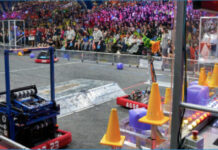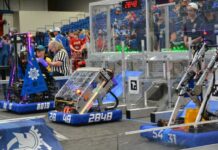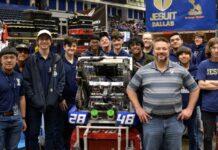On February 17, a minute before midnight, the defending champion Team 2848 Jesuit All Sparks finalized their “groundbreaking build season as they bagged another tournament robot,” according to club moderator Mr. Michael Couvillon. Reflecting on the season, he mentioned that with this year came “a more thorough prototyping process supported by an arsenal of fabrication machinery. The CNC laser table and 3D printers were always abuzz while students loaded their latest design iterations.”
A fresh design and better machinery aren’t the only new things this year for last year’s world championship winners, the team also began posting on a blog throughout the build process, detailing the struggles and triumphs of their pre-competition activities. The Robotics team started 7 years ago, as noted in the first post, which went on to summarize the rapid growth of the program, which has ballooned to “40+ students with 9 mentors, a drastic improvement from our meager beginnings.”
With a new build season comes a new challenge, and this year’s competition is entitled Recycle Rush. (The details of the competition can be found here.) Each robot must build a stack of boxes, top the stack with a recycle bin, and then recycle litter into the bin. Two squads composed of three teams each battle it out on a 27 foot by 54 foot field, divided into red and blue sides. Alliances try to cooperate in order to stack towers more quickly. The team spent a lot of time during the prototyping stage trying to maximize points with the least work necessary. According to their “Breakdown Of The Game” post: “A single stack of six totes without any containers is worth exactly as many points as two totes with one container stacked on top of it. Containers will be extremely important to any high-scoring strategies this year, but at the same time, a container by itself is worth zero points.”
The team ran “predictive analysis of game play” in order to find the maximum amount of possible points (which they agreed to be 434 on a “perfect” game) an alliance could score, as well as the highest score an individual robot could receive (240 points). An issue the team found was in the randomness of team grouping. “In this game, an ideal alliance would consist of robots that each specialize in different tasks working together,” the team noted, but an ideal alliance is something you can’t count on. Due to alliances being chosen at random, a group could end up entirely composed of tote stacking robots, with no bots to move recycling bins. Worse still, a team could end up with the same style of bot as one teammate, and be left out to dry by a team who didn’t pass inspection.
Teams that would like to make a bot as a jack of all trades run into size and weight requirements. The maximum weight for each robot is 120 pounds, and each robot must condense into a 28″ x 42″ x 78″ box at the largest, but are allowed to expand in width and length once on the field. Jesuit’s approach? “Our team’s goal is always to be able to do one task exceptionally well, and we will fit in any of the other tasks that we think could be helpful as size and weight permit.” Michael Mong ’16 worked as a design team member, helping to “design the concepts which we brainstorm as a team using the computer aided design software, Solidworks…The design team members led prototype teams to test our designs and determine which were the best solutions to the problems.” On the unique Recycle Rush Challenge, Mong said, “This year’s challenge is different from previous years, as completion and interaction with the opposing alliance is diminished. I feel that this creates an emphasis on unique designs, as they removed the restriction on dimensions once the match starts; however, the reduced competitive nature makes the game less fun to watch. The new model does allow for more focus on unique solutions to the given challenge.”
With the complexity of the competition and the stringent requirements in mind, this is what Team 2848 has created. The All Sparks traveled to the Irving Convention Center in order to participate in the Dallas FRC Regional. The team ended the tournament at 22nd, lower than their placing at last year’s Dallas regional, but not too shabby for a tournament of such size. Mong reflected on their robot in light of the tournament results, noting that “I believe we designed and assembled a robot which met the goals that we set at the beginning of the season; however, the game did not play out as we anticipated and we are working on possible changes before our next competition. I believe that we performed as well as we expected, but there are some redesign issues which will have to be addressed based on how the game played out.” Looking forward, he also shared that “Our team’s goal is to return to Einstein Field where we won the Championship last year.”
Link to robot reveal video:. https://www.youtube.com/watch?v=60YK0UmaMFk
Link to game reveal video from January: https://www.youtube.com/watch?v=W6UYFKNGHJ8&list=PLZT9pIgNOV6asdCocQb2c2LGLl1cWQ0yh
Blog: http://makezine.com/2015/01/09/meet-the-all-sparks-a-dallas-based-high-school-robotics-team/
For dates of future competitions: http://www.usfirst.org/roboticsprograms/frc/calendar/






